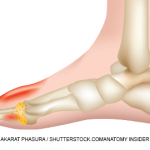ATLANTA—The authors of the new draft ACR treatment guideline for the management of gout presented the draft guideline on Nov. 13 at the 2019 ACR/ARP Annual Meeting. Based on evidence from more than 130 published studies, there are 42 recommendations, of which 16 were strong, including 27 for urate-lowering therapy (ULT) management, 13 of which were strong; five each for managing gout flares and lifestyle recommendations; four for management of other medications for patients with gout; and one for asymptomatic hyperuricemia management. The previous ACR gout guidelines were published in 2012.
“We are now preparing the manuscript for journal peer review, and then need to have a final approval vote by the board of directors prior to publication,” said John D. FitzGerald, MD, PhD, co-principal investigator of the new guideline and past chair of the ACR’s Quality of Care Committee. Following the board’s approval, simultaneous publication in Arthritis & Rheumatology and Arthritis Care & Research is expected in 2020.
The guideline was developed using GRADE (Grading of Recommendations Assessment, Development and Evaluation) methodology and included input from an eight-patient panel and consideration of therapies’ cost based on average wholesale pricing for each drug, said Dr. FitzGerald, a rheumatology researcher at the University of California, Los Angeles (UCLA) David Geffen School of Medicine. To assess risk of bias of evidence, guideline investigators used the Cochrane risk-of-bias tool for randomized controlled trials and the ROBINS-I (Risk of Bias in Non-Randomized Studies—of Interventions) tool for observational studies.
New Strong Recommendations
Sixteen strong recommendations included changes from the 2012 guidelines, such as a recommendation for following a treat-to-target strategy of dose management when treating all gout patients with serum urate-lowering therapy (ULT) that includes dose titration and subsequent dosing guided by serial serum urate values to achieve a target over a fixed, standard dose ULT strategy, and a new recommendation for all patients on ULT to continue therapy to achieve and maintain a target of 6 mg/dL over using no target.
Other strong recommendations include:
- Initiating ULT in gout patients with one or more subcutaneous tophi over no ULT;
- Initiating ULT in patients with radiographic damage, using any modality, that is attributable to gout;
- Initiating ULT in patients with frequent gout flares, or two or more per year;
- Use of allopurinol as the first-line ULT, including in gout patients with stage 3 or worse chronic kidney disease (CKD);
- When using allopurinol or febuxostat as ULT, starting at low dose, with subsequent dose titration to target over a higher dose, such as 100 mg/day or less for patients taking allopurinol or a lower dose for patients with chronic kidney disease, and 40 mg/day or less for patients taking febuxostat;
- Use of concomitant anti-inflammatory prophylaxis over no prophylaxis when patients start ULT for at least three to six months, rather than less than three months, with evaluation and continued prophylaxis if the patient keeps having flares;
- Use of colchicine, non-steroidal anti-inflammatory drugs or glucocorticoids as appropriate first-line therapy for gout flares over interleukin (IL) 1 inhibitors or adrenocorticotropic hormone (ACTH);
- When colchicine is the chosen agent for managing a gout flare, use of low-dose over high-dose colchicine given its similar efficacy and less adverse effects; and
- For patients with gout who have failed to achieve serum urate targets with xanthine oxidase inhibitors (XOIs), uricosurics and other interventions, and who have frequent gout flares or non-resolving tophi, switching to pegloticase over continuing the current ULT.
Pegloticase, HLA-B*5801 & Lifestyle Changes
The guideline also includes strong recommendations against the use of pegloticase as a first-line urate-lowering therapy. In patients who have infrequent gout flares and no tophi, but have not achieved the serum urate target despite xanthine oxidase inhibitors, uricosurics and other interventions, a strong recommendation is made against switching to pegloticase over continuing their current therapy. However, for patients who have failed xanthine oxidase inhibitors, uricosurics and other interventions, a strong recommendation is made to switch to pegloticase.
New conditional recommendations compared with the 2012 guidelines include testing HLA-B*5801 in African Americans and patients of Southeast Asian descent before starting allopurinol, due to the higher prevalence of this gene in these populations, and against this test in all other gout patients.
A new conditional recommendation is for an augmented ULT protocol, including patient education and shared decision making, to be managed by a non-physician healthcare provider, such as a nurse, to optimize the patient’s treat-to-target strategy. Lifestyle management advice for all gout patients regardless of disease activity includes a conditional recommendation for limiting alcohol, purine and high-fructose corn syrup intake, and a conditional recommendation against adding vitamin C supplementation to therapy.
Clinical Scenarios
Co-investigators presented patient case examples to illustrate applications of the recommendations. Nicola Dalbeth, MBChB, MD, professor of medicine at the University of Auckland, New Zealand described a 54-year-old white man who presented to the clinic with an acute, painful gout flare in his left ankle and first metatarsophalangeal joint. He’d had three previous gout flares, the first one at age 50, but no other flares in the past year. On presentation to his provider, he had new-onset difficulty with walking due to severe pain and no evident subcutaneous tophi, and was not on any current ULT. He had type 2 diabetes, stage 3 CKD and hypertension, and was taking aspirin, simvastatin, lisinopril and hydrochlorothiazide. In 2018, his serum urate was measured at 9.5 mg/dL.
“If this was his first gout flare, would we recommend commencing urate-lowering therapy? The guideline states that for patients experiencing their first gout flare, we conditionally recommend against ULT with the following exceptions: if the patient has CKD stage 3 or worse, a serum urate level above 9 or kidney stones, we conditionally recommend initiating urate-lowering therapy. So even if this was his first flare, because he has CKD-3 and documented hyperuricemia at a high level, there would be a conditional recommendation to begin urate-lowering therapy,” said Dr. Dalbeth.
Because this patient presented with a current flare, there is a conditional recommendation to start ULT during the flare over starting ULT after the flare has resolved, she added.
“If he does start ULT, which ULT should he start?” asked Dr. Dalbeth. “For patients starting any ULT, we strongly recommend allopurinol over other urate-lowering therapies as the preferred first-line agent for all patients, including those with CKD stage 3 or worse, and we strongly recommend against pegloticase as first-line therapy.”
He was prescribed 50 mg per day of allopurinol, and his dose was increased to 100 mg per day after one month until his next clinic visit. Based on a strong recommendation in the guideline to start anti-inflammatory prophylaxis, the patient also began taking colchicine at 0.6 mg per day.

Dr. Ted Mikuls
“How long should this patient remain on urate-lowering therapy? As a conditional recommendation, we recommend continuing urate-lowering therapy indefinitely over stopping urate-lowering therapy,” said Ted. R. Mikuls, MD, MSPH, Umbach Professor of Rheumatology at the University of Nebraska Medical Center and a rheumatologist at the Omaha Veterans Administration Hospital. “How long should this patient remain on colchicine prophylaxis? We strongly recommend continuing prophylaxis for at least a three-to-six-month period rather than less than three months, with ongoing evaluation, and to continue prophylaxis as needed if the patient continues to experience gout flares.”
What lifestyle management changes should a physician suggest for this patient moving forward? Based on conditional recommendations for patients with gout at any level of disease activity, physicians shouldsuggest that he limit alcohol, purine and high-fructose corn syrup intake and lose weight, but not adding vitamin C supplementation, said Dr. Mikuls.
‘We don’t have randomized trials to address every single clinical question of relevance. We need to be able to look at other evidence to help develop actionable guidelines.’ —Dr. Neogi
In another clinical scenario, a 58-year-old African American man presented to the clinic for ongoing management of his advanced gout. Three weeks after he started allopurinol therapy years ago, he experienced generalized rash, fever, eosinophilia and acute kidney injury, said N. Lawrence Edwards, MD, MACP, MACR, vice chair, graduate medical education at the University of Florida, Gainesville. The patient had no ULT for the next 14 years. His joint pain progressed. He had frequent gout flares and developed multiple tophi. He experienced gout flares every six to eight weeks. At presentation, he had low-grade synovitis in his wrists and ankles and a serum urate of 10.8 mg/dL, and his hand X-rays showed extensive erosive changes.

Dr. Edwards
“Should this patient be started on a ULT? Well, you can see that he checks all the boxes for strong recommendations for starting a ULT: he has one or more subcutaneous tophi, he has radiographic damage illustrated on any modality, and he has frequent flares,” said Dr. Edwards. “Which ULT should he start? Well, he is not going to go back on allopurinol, so febuxostat. In this case, there is a strong recommendation for at starting at a low dose with subsequent dose titration to a target over starting at a higher dose and staying there.”
The patient was prescribed 40 mg/day of febuxostat to start, and based on another strong recommendation, began to take 0.6 mg/day of colchicine as concomitant anti-inflammatory medication. The patient’s treatment was adjusted to reach a target of 6 mg/dL, not to alleviate his many gout symptoms, and his febuxostat was increased to 80 mg/day two months later because his serum urate failed to reach the target, said Dr. Edwards. His tophi were also unchanged. Based on another strong recommendation, the patient was switched to pegloticase for six months until his serum urate improved to 3.7 mg/dL. His flares and tophi resolved, and he was transitioned back to 80 mg/day of febuxostat with close follow-up.
Frequent Updates Reflect New Evidence

Dr. Neogi
Data published after 2012 supported several important changes, said co-principal investigator Tuhina Neogi, MD, PhD, rheumatology section chief and professor of medicine at Boston University School of Medicine. Recent trials that panelists used to support recommendations include a 2017 randomized, controlled trial on the benefits of febuxostat in patients with early gout and infrequent flares; the 2018 CARES Trial, which compared the cardiovascular safety of febuxostat and allopurinol; and a 2019 study on the benefits of nurse-led gout care, which supported the conditional recommendation for augmenting ULT with evaluation by a non-physician healthcare provider.1-3
The ACR’s methodological approach to guideline development, which includes consideration of the totality of the literature, may differ from other societies, she said. The ACR’s recommendations are made largely on the basis of quality of evidence (among other factors), and strong recommendations are usually based on the results of randomized, controlled trials, but “some specialty societies will only make recommendations in the context of randomized trials. We don’t have randomized trials to address every single clinical question of relevance. We need to be able to look at other evidence to help develop actionable guidelines.”
Susan Bernstein is a freelance journalist based in Atlanta.
References
- Dalbeth N, Saag KG, Palmer WE, et al. Effects of febuxostat in early gout. Arthritis Rheumatol. 2017 Dec;69(12):2386–2395.
- White WB, Saag KG, Becker MA, et al. Cardiovascular safety of febuxostat or allopurinol in patients with gout. N Engl J Med. 2018 Mar 29;378(13):1200–1210.
- Doherty M, Jenkins W, Richardson H, et al. Efficacy and cost-effectiveness of nurse-led care involving education and engagement of patients and a treat-to-target urate-lowering strategy versus usual care for gout: A randomised controlled trial. Lancet. 2018 Oct 20;392(10156):1403–1412.
Editor’s note: This article was edited on Dec. 5 to reflect current information.


